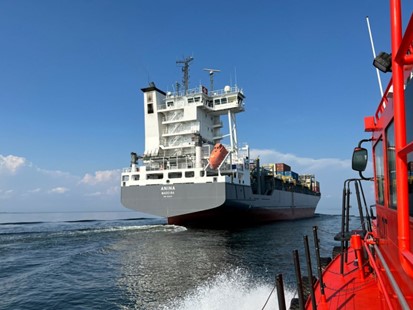Pilot boat L 243 incident south of Orrengrund on 1 December 2024
Course of events
The pilot boat L 243 was on its way to pick up a pilot from the vessel MV Elbwind (CY) on 1 December 2024. While waiting for the pilot pick-up, L 243 followed Elbwind, keeping behind it. The incident occurred when at the end of the pilotage Elbwind started a steep turn to the port as requested by the pilot. As a result, the pilot boat L 243 following in close proximity ended up in Elbwind’s stern wake region. The turn took the pilot boat master by surprise, and he tried to evade the turning ship by turning port. At that point, as a combined effect of strong vortices caused by Elbwind’s turn, the powerful forward thrust of L 243’s engines and turning to the port, L 243 listed significantly. The pilot boat master managed to get the situation under control by shifting the engines to full reverse and turning the rudder amidship. This increased the distance to the turning vessel.
After the incident, the pilot boat approached Elbwind again, and the pilot was able to transfer to the boat safely. The vessel’s crew or the pilot leaving the bridge did not observe the incident that occurred.
Finnpilot prepared an incident report on the event and launched an internal investigation. The Safety Investigation Authority was informed of the incident on 5 December 2024.
Background information
Before leaving the Mussalo Harbour, MV Elbwind master and the pilot discussed where the pilot ladder would be placed. Due to wind and wave conditions, it was decided that the pilot ladder be placed on the port side of the vessel. The pilot forwarded this information to the pilot boat crew.
The risk of strong backflow vortices caused by a ship making a sharp turn is a commonly recognised phenomenon. This is also discussed in Finnpilot’s safety manual, which provides instructions on how pilot boats should cross a ship’s stern wake and maintain a safe distance when dropping off or picking up a pilot. If necessary, the stern wake should be crossed at an as perpendicular angle as possible. As a rule, the safety distance off the ship’s stern should be at least 100 metres.

The safety manual discusses how a pilot boat should be operated at the side of a vessel mainly from the perspective of ensuring the safe transfer of a pilot. Less attention is paid to instructions related to how a pilot boat should pull up alongside a vessel safely. According to the manual, the pilot boat master decides whether it is safe to pull up the boat to the side of a vessel.
Communication between the vessel, pilot and Vessel Traffic Service (VTS) takes place in English. This common language enables, among other things, immediate exchange of information between the vessel and the pilot boat during the period when the pilot is moving from the bridge to the pilot ladder on the vessel’s deck.
Observations
A pilot boat must not get too close to a vessel’s stern wake region when preparing for dropping off or picking up a pilot. This is why the Safety Investigation Authority emphasises the importance of sufficient safety distances.
Finnpilot’s safety manual emphasises the pilot’s communication with the vessel and the pilot boat regarding how the pilot boat should pull up alongside the vessel. It does not specify in more detail the factors affecting the decisions made by the pilot boat master from the time when the boat begins to pull up alongside the vessel or how to ensure the approach. The prerequisite for the pilot boat to pull up safely alongside the vessel is a joint understanding between the crew on the bridge of the vessel, the pilot and the pilot boat master on how to time the operations in the prevailing conditions.
The Safety Investigation Authority emphasises the importance of clear communication and using a common language between the vessel, the pilot and the pilot boat.
Additional information:
Chief Investigator Risto Haimila, tel. +358 29 515 0730, e-mail: [email protected]
Published 11.2.2025
